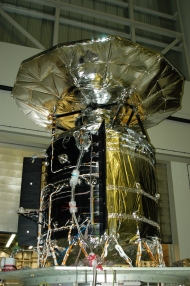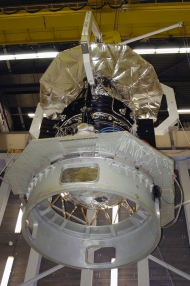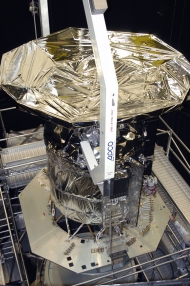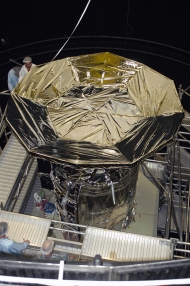Installation for Space Simulator Test
21 September 2005
Preparations for the upcoming test of the Herschel payload module in the large space simulator at ESTEC are well underway, with the installation of the module in the test facility.
 |
 |
|
The Herschel payload module under way from its integration hall to the large space simulator test facility. | |
The Herschel payload module primarily consist of the cryostat vacuum vessel and the telescope. The octagonally shaped plate and cylindrical ring at the bottom of the vessel represents the service module. The detailed model of this module has already been thermally tested and will be mated with the payload module later this year for complete mechanical tests at satellite level.
The bottle shaped vacuum vessel contains the optical bench carrying the three focal plane instruments, a 2360-litre tank with liquid helium in superfluid state (1.8K) and a 80-litre tank with liquid helium at 4K acting as pre-cooling stage during autonomy periods on the ground. The black half of the vessel is facing cold space and act as a radiator while the shiny part is facing the relatively warm sun shade and will block/reflect away the incoming heat rays.
The telescope is in this thermal test configuration not the real telescope but replaced by a representative model in terms of primary mirror dimensions and thermal properties.
 |
 |
|
The payload module under installation in the large space simulator test facility where a thermal vacuum test will be performed. | |
The payload module is under installation in the large space simulator test facility where a thermal vacuum test will be performed. The payload module will be exposed to liquid nitrogen cooled shrouds at ~80K. There will be no sun simulation during this test but a huge heated screen is installed into the vacuum chamber to represent the infrared radiation from the sun shade of the satellite in orbit. The main objective of this test is to verify the performance of the internal design of the cryostat and in particular the achieved temperatures at the instrument interfaces and the helium lifetime. The test duration will be about 25 days starting on the 4th of October.

